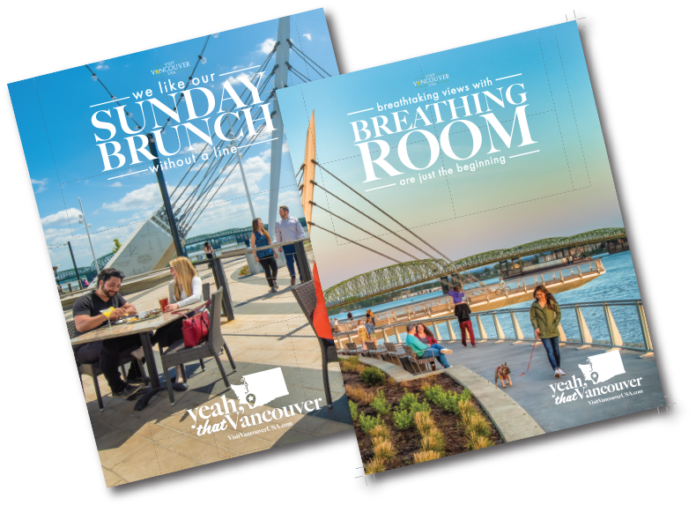Vancouver has long based its identity in an identity crisis. It’s not Vancouver BC, T-shirts and bumper stickers read. It’s also not Washington D.C., and it’s definitely not Portland, Ore.
Visit Vancouver USA is poised to own that crisis and transform it into a connection. Billboards and print advertising across the metro area will point to our emerging destination status with a slogan that portrays bonding and affinity, but also a sense of curiosity: “Yeah, that Vancouver.”
Today’s Vancouver is poised to become one of the premier destinations in the West thanks to a multi-factored approach that includes a brand new statewide marketing effort and funding, significant ramping up at Visit Vancouver USA, the push of the Portland Metro area northward and, above all, the Vancouver Waterfront development.
Numbers are up
According to visitvancouver.com, “a recent report conducted by Dean Runyan Associates for the Washington Tourism Alliance shows that visitor spending to Clark County in 2018 was more than $585 million — a 15.1% increase from 2017. Last year, Clark County saw an 8.5% increase from the previous year, and in 2016 visitor spending increased by 4.7%. The report also revealed that travel-related employment was up 9% in Clark County, and total tax revenue from visitors equaled $52 million, an 8.6 percent increase from 2017.”
In addition, from the Dean Runyan report, “Washington State Travel Impacts and Visitor Volume,” Clark County has seen increased tourism-related spending across the board:
- Accommodations: 13.1% increase (up from $82.2 million to $93 million)
- Food Stores: 13.9% increase (up from $50.8 million to $57.9 million)
- Arts, Entertainment and Recreation: 14.1% increase (up from $61.5 million to $70.2 million)
- Retail sales: 13% increase (up from $71.1 million to $80.4 million)
- Food service: 16.2% increase (up from $135 million to $156.9 million)
Michelle McKenzie, the recently hired director of Marketing at Visit Vancouver USA, said the mojo is appropriately attributed to the Waterfront development. Though only officially open for less than a year, the Vancouver Waterfront has proven to be a catalyst for the market like no other, contributing significantly to downtown’s population density, prompting regional restaurants and wineries to move here, and catalyzing businesses to HQ on this side of the river.
“The Waterfront is only going to be more popular. It’s the hook that lures people over to Vancouver,” McKenzie said.
Before picking up this role, McKenzie spent five years in consumer marketing at Travel Portland. In her role as marketing manager there, she oversaw a destination rebranding effort, implemented annual marketing campaigns and managed Portland Dining Month.
Under McKenzie’s direction, Visit Vancouver has a launched “Yeah, that Vancouver,” a branded campaign throughout the Portland Metro area, which will come alive on billboards, digital video, print and sponsored content.
Ads include taglines like “breathtaking views with breathing room are just the beginning” and “we like our Sunday brunch without a line,” playing up the aspects of destination dining and shopping while capitalizing on that elusive and beloved Pacific Northwest peacefulness and nature.
Statewide support
In addition to the local push, this is the first full fiscal year of the statewide tourism marketing account that was signed into law last year, driven by the Washington Tourism Alliance, a membership-based nonprofit organization that was established after the closure of the Washington State Tourism Office in 2011. In July of 2017, the Washington State Legislature allocated funding to the Department of Commerce to work with the WTA to create a Tourism Marketing plan for Washington state. In March of 2018, Gov. Jay Inslee signed into law E4SSB 5251, which establishes framework and funding for a statewide tourism marketing program for the first time in seven years.
The marketing plan is comprehensive, and it includes:
- Research that identifies domestic and international markets that will give a high return on investment
- Survey results of people likely to travel in the Western states in the next couple of years
- Survey results that identify what is top of mind for people traveling to Washington state
- Personas of likely visitors and journey maps
- Strategies and tactics to increase visitation to Washington state
- Tools to measure return on investment and key performance indicators
Clark County should see about $1.5 million per year in state funding, “based on how those marketing plans develop,” said McKenzie. “We will partner with them on supporting their marketing efforts.”
Getting down to business
Visit Vancouver USA is locally funded by a Tourism Promotion Area, which charges all hotel guests with a flat $2 per night charge and applies only to room night charges at hotels with 40 or more rooms. Total TPA collections in 2018 were $1,193,860. Visit Vancouver USA also receives 15% of lodging tax collections. With additional hotels opening in the city, this three-year professional services contract is expected to increase from about $350,000 in 2019 to approximately $450,000 in 2021.
Under its services contract as a nonprofit destination management organization, Visit Vancouver USA provides a variety of services aimed at promoting Vancouver as a meetings and leisure destination, increasing meeting and convention conversions, assisting meeting and tour planners, providing marketing opportunities for local businesses and offering visitor assistance.
Also new to the team, director of Business Development Chuck Ryder will lead the business development and convention services team to drive overnight bookings and group business.
At the end of June, 20-year Visit Vancouver veteran Kim Bennett will step down as president and CEO. The board of directors is currently engaged in a regional search for her replacement.
“Kim will be missed,” said McKenzie. “She left a great legacy.”




